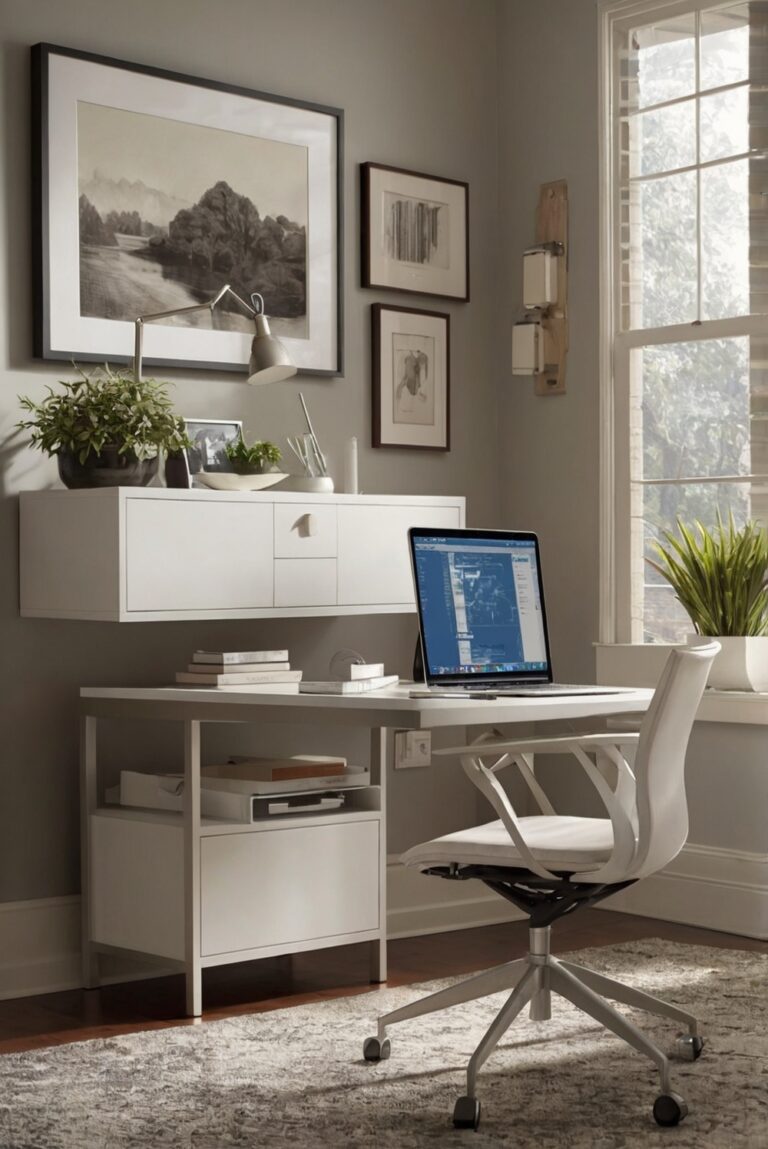Find out how to enhance your workspace with these simple daily interior designer routines to make your home office desk more adjustable and productive.
To make your home office desk more adjustable, you can consider the following tips:
1. Invest in a height-adjustable desk or a desk converter to accommodate sitting and standing positions.
2. Use monitor arms to easily adjust the height and angle of your screens for ergonomics.
3. Incorporate movable storage solutions like rolling drawers or cabinets for flexibility.
4. Add task lighting options such as desk lamps with adjustable arms to control brightness.
5. Use cable management tools to keep your workspace organized and clutter-free.
6. Consider using ergonomic chairs with adjustable features for enhanced comfort during long work hours.
These adjustments can enhance your home office decor while promoting a healthy and productive workspace.
Adjustable Home Office Desk
When it comes to creating a productive and ergonomic workspace, having an adjustable home office desk is crucial. Here are some tips on how you can make your home office desk more adjustable:
Ergonomic Chair
Investing in an ergonomic chair is essential for creating a comfortable and adjustable workspace. Look for a chair that offers adjustable height, lumbar support, and armrests. This will help you maintain proper posture and reduce the risk of back and neck pain.
Adjustable Desk Height
Consider using a desk that offers adjustable height settings. This will allow you to switch between sitting and standing throughout the day, promoting better circulation and reducing the strain on your back and legs. Look for desks with electric or manual height adjustment options.
Monitor Placement
Ensure that your monitor is positioned at eye level to prevent neck strain. Use a monitor stand or adjustable monitor arm to achieve the optimal viewing angle. This will help reduce eye fatigue and improve your overall posture while working.
Keyboard and Mouse Position
Place your keyboard and mouse at a comfortable distance from your body to prevent strain on your wrists and shoulders. Consider using a keyboard tray or an adjustable keyboard stand to achieve the right ergonomic position. This will help reduce the risk of repetitive strain injuries.
Cable Management
Keep your workspace organized by using cable management solutions to prevent clutter and tripping hazards. Use cable clips, trays, or sleeves to route cables neatly along the desk or wall. This will not only improve the aesthetics of your workspace but also make it easier to adjust and move your devices.
In conclusion, creating an adjustable home office desk involves investing in ergonomic furniture, adjusting the height of your desk and monitor, optimizing your keyboard and mouse position, and managing your cables effectively. By following these tips, you can create a comfortable and productive workspace that promotes good posture and reduces the risk of musculoskeletal injuries.
1. What are some ways I can make my home office desk more adjustable?
To make your home office desk more adjustable, consider investing in an ergonomic chair that supports your back and promotes good posture. Additionally, you can use a monitor stand to adjust the height of your screen to eye level, reducing strain on your neck. An adjustable keyboard tray can also help you position your keyboard and mouse at the right height to prevent wrist pain. Standing desks are becoming increasingly popular for their adjustable height feature, allowing you to switch between sitting and standing throughout the day.
2. How can I improve the ergonomics of my home office desk?
Improving the ergonomics of your home office desk is crucial for your overall comfort and productivity. Start by adjusting the height of your chair so that your feet are flat on the floor and your knees are at a 90-degree angle. Position your monitor at eye level and an arm’s length away to reduce eye strain. Use a wrist rest for your keyboard and mouse to maintain a neutral wrist position. Consider adding a footrest to support your feet and promote better circulation while sitting.
3. What are the benefits of having an adjustable home office desk?
Having an adjustable home office desk offers numerous benefits, including improved comfort, reduced risk of musculoskeletal disorders, and increased productivity. By being able to adjust the height of your desk, chair, and monitor, you can find the perfect ergonomic setup that suits your body and working style. Standing desks allow you to alternate between sitting and standing, reducing the negative effects of prolonged sitting. Additionally, an adjustable desk promotes better circulation, reduces fatigue, and enhances focus and concentration.
4. Are there any DIY solutions to make my home office desk more adjustable?
If you’re looking for budget-friendly DIY solutions to make your home office desk more adjustable, consider using furniture risers to raise the height of your desk or monitor. You can also use books or boxes to create a makeshift monitor stand to achieve the ideal viewing angle. Adding a keyboard tray under your desk can help you adjust the position of your keyboard and mouse for better ergonomics. For standing desks, you can use adjustable shelving units or crates to create a makeshift height-adjustable desk.
5. What are some tips for maintaining an adjustable home office desk?
To ensure your adjustable home office desk remains in good condition and provides optimal comfort, it’s important to practice regular maintenance. Clean your desk regularly to remove dust and debris that can affect its adjustability. Lubricate moving parts, such as height adjustment mechanisms, to prevent stiffness and ensure smooth operation. Check for any loose screws or bolts and tighten them as needed to maintain stability. Avoid placing heavy objects on your desk that could affect its ability to adjust. Finally, follow the manufacturer’s guidelines for adjusting and using your desk to prolong its lifespan.







